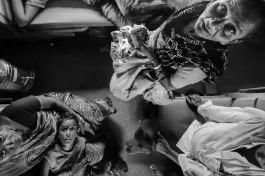On 11 July 2025, during a World Population Day Summit, Andhra Pradesh Chief Minister N. Chandrababu Naidu declared, “We will launch a robust policy on population growth soon. Population is our strongest economic resource. The world is increasingly reliant on countries with large populations”.
This statement is not an isolated one. It reveals a rising trend in India, especially in the southern states, where declining fertility rates are increasingly seen as a concern. While the official reasoning primarily points to fears about a shrinking labour force, slowed economic growth, and an ageing population, there are deeper political undercurrents at play (Lyngdoh et al. 2024; Saggurti and Gupta 2025).
Although India claims to practice cooperative federalism, southern states have become increasingly sceptical about how it actually operates. This scepticism has led to more contestation in federalism. Key issues include the way fiscal federalism is managed, the push for linguistic centralisation—especially through the imposition of Hindi—and the misuse of the governor’s powers in state affairs.
Fiscal federalism is strongly linked to population numbers. For instance, the formula used by the ongoing 15th Finance Commission to decide how tax revenues are shared among states now relies on data from the 2011 Census. It also recommends allocations for several centrally sponsored schemes based on per-capita figures. This change especially affects grants for health, local governance, and disaster management.
Frequently, policy decisions seem to favour investment in states that perform poorly, rather than rewarding those that have done well. This pattern is often reinforced by favouritism towards states that are politically aligned with the central government.
Against this backdrop, the upcoming delimitation exercise—which will redistribute parliamentary seats using updated population data—has created significant unease. Southern states fear losing political representation and becoming marginalised. Meanwhile, states with higher fertility rates may gain disproportionate influence. These fears have encouraged subtle, but increasing, support for pro-natalist policies that can come at the cost of individual rights and reproductive autonomy. This debate reflects a broader struggle involving demographics, social and cultural factors, governance, and equitable federalism.
Conflicted Policy Landscape
India’s approach to reproductive health and population control has long been shaped by cultural, social, and political factors. India was among the first countries to introduce a state-sponsored family planning programme in 1952.
Since its inception, the programme was shaped by the belief that “development is the best contraceptive”. Rooted in a neo-Malthusian worldview, it assumed that unchecked population growth threatened limited resources and economic development, thereby perpetuating poverty. Western countries strengthened this view. They promoted population control in the global South—especially in India—as necessary for global stability and progress towards modernisation.
India’s population policies have traditionally focused on numbers, such as the total fertility rate and child sex ratio. There has been much less attention paid to individual autonomy.
In its early decades, the family planning programme adopted a coercive, target-driven approach. Both users and healthcare workers were incentivised for permanent methods of contraception. At that time, abortion became legal under certain conditions. This decision was debated as not just a way to improve public health and reduce deaths among mothers, but also as an effort by demographers to control population growth.
These strategies culminated in widespread coercion, especially during the Emergency period, which was marked by mass vasectomy drives and serious human rights violations. Public backlash from this period, combined with India’s endorsement of the Programme of Action (PoA) at the 1994 International Conference on Population and Development (ICPD), prompted a largely symbolic policy shift.
“Targets” were replaced with “Expected Levels of Achievement” but coercive practices persisted under the rebranded “Family Welfare Programme”. Though the “basket of choice” approach aimed to promote autonomy and informed decision-making among users, healthcare providers’ preferences, influenced by institutional targets and population control imperatives, continued to shape services.
In reality, healthcare providers often push users to choose certain methods, which means people do not truly have freedom to decide for themselves. This shows a deeper, unresolved problem: there is a gap between supporting reproductive rights in principle and how the programme actually works in practice.
During this time, the Pre-Conception and Pre-Natal Diagnostic Techniques (PCPNDT) Act of 1994 was introduced to stop the misuse of technology for sex-selective practices. However, the way the Act was enforced sometimes ended up restricting access to second-trimester abortion services—whether intentionally or not. Its strict penalties created fear among service providers, who worried about facing legal consequences.
Public campaigns around the Act were meant to raise awareness about the importance of girls. But they often led people to think that most second-trimester abortions were done for sex-selective reasons. These messages also, perhaps unintentionally, suggested that foetuses have personhood. This strengthened stigma around abortion and supported arguments against the right to choose.
The lack of clear communication about the necessity, legality, and safety of abortion services has allowed negative views to spread. As a result, enduring social and psychological barriers now make it harder for people to access abortion services.
Further, adding to these challenges, India’s legal framework carries strong anti-choice underpinnings as well. The Indian Penal Code of 1860, a colonial legacy, criminalised abortion under Sections 312 to 314, reflecting a moral and religious opposition to abortion and birth control. These provisions were retained almost unchanged in the Bharatiya Nyaya Sanhita (BNS) of 2023. As a result, abortion continues to be criminalised in the country, permitted only as an “exception” under the Medical Termination of Pregnancy Act, 1971.
The Millennium Development Goals, introduced in 2000, influenced the Reproductive and Child Health-II strategy. This led to a strong focus on reducing maternal mortality. These priorities laid the groundwork for the National Health Mission. Later, the Sustainable Development Goals continued to emphasise the reduction of maternal deaths.
However, during the same period, strategies such as Family Planning 2020 and Family Planning 2030 pushed forward the agenda of population stabilisation (Family Planning 2030). Thus, in practice, India’s policy environment remains a confusing mix of pro-natalist, pro-choice, and anti-choice elements, often reflecting conflicting state priorities.
Myth of Free Choice
Supporters of sexual and reproductive health rights and justice uphold each person’s basic right to make free, informed, and voluntary decisions about their body, sexuality, and reproductive life. This covers choices about contraception, pregnancy, childbirth, abortion, sexual partners, and family planning methods.
Real freedom of choice means much more than just having laws or limited government schemes in place. It requires an environment where people have access to comprehensive information and healthcare, economic stability, protection from violence and discrimination, and support for removing systemic barriers—especially for marginalised communities. For this reason, it is essential to examine policy through a wider lens of justice and equity, rather than focusing only on legal rights or programme details.
These policy contradictions highlight a narrow focus on demographics. The government often encourages childbirth rather than providing lasting support for parenting and child-raising, especially among marginalised families.
India’s population policies have traditionally focused on numbers, such as the total fertility rate (TFR) and child sex ratio. There has been much less attention paid to individual autonomy. This gap between a numbers-driven approach and one that truly respects human rights, dignity, and fairness in reproductive health is clear. In practice, policy implementation continues to be shaped by demographic targets and political concerns rather than by a commitment to individual rights.
In 2020, both the Delhi High Court and the Supreme Court rejected a petition seeking the enforcement of a national two-child norm, affirming India’s commitment to reproductive rights and voluntary choice under the International Conference on Population and Development’s Programme of Action and the principles enshrined in the National Population Policy (MoHFW 2002; NPP 2000).
Despite the official rhetoric of voluntary choice, government policies and schemes remain inconsistent. On one hand, they adopt a pro-natalist approach by offering cash incentives for childbirth, particularly among communities facing population decline such as the Parsis (Jiyo Parsi Scheme) and the particularly vulnerable tribal groups (PVTGs).
At the same time, more than 35 Bills advocating a two-child policy have been introduced in India’s legislatures since independence. Several states have passed laws that penalise people with more than two children. They restrict access to government schemes, jobs, and even eligibility for political office, which results in unfair treatment of these individuals. 1Rajasthan (1992), Odisha (1993), Haryana (1994), Andhra Pradesh (1994), Himachal Pradesh (2000), Madhya Pradesh (2000), Chhattisgarh (2000), Uttarakhand (2002), Maharashtra (2003), Gujarat (2005), Bihar (2007), and Assam (2017).
Policies like these have serious negative consequences. They lead to skewed sex ratios, trafficking of women, forced marriages, sexual exploitation, and abandonment. A recent case in Madhya Pradesh—where a fourth-born child was nearly killed because the parents feared losing their government job—shows how severe these outcomes can be. These issues are not just statistics; they are deep human rights crises.
These policy contradictions highlight a narrow focus on demographics. The government often encourages childbirth rather than providing lasting support for parenting and child-raising, especially among marginalised families. For example, programmes like Janani Suraksha Yojana (JSY) and Beti Bachao Beti Padhao (BBBP) promote institutional births and short-term maternal health, as well as survival of girls. However, they do very little to support long-term care or invest in proper child care infrastructure.
Although these schemes are presented as advancing gender equity, in reality, they reflect a state-driven approach to reproduction. Certain births—especially of daughters—are given priority to fulfil demographic and social goals based on a heteronormative, patriarchal mindset. State-level pro-natalist policies, often framed as responses to perceived demographic threats, assign national importance to having children. Yet they fail to provide the structural support needed to raise children in safe and healthy environments.
For example, the Integrated Child Development Services (ICDS) programme was set up in 1975 to provide early childhood care through anganwadi centres. But the ICDS remains underfunded and stretched thin. This lack of adequate support puts an unfair burden on women, often forcing them to leave the workforce and reinforcing persistent gender inequalities.
For many women, infertility has serious social consequences. Women may face stigma, blame, discrimination, social exclusion, emotional distress, and even abandonment.
While many assume that falling fertility rates reflect women’s personal choices, the reality is much more complex. Structural inequalities, gender norms, and coercive practices all influence reproductive decisions—especially among marginalised and poor communities.
A clear example is the denial of contraception to 75 state-recognised particularly vulnerable tribal groups (PVTGs). In 1979, the government banned sterilisation for these groups. This order was presented as a way to protect them from coercion. However, the underlying intention was pro-natalist: the aim was to boost their population by restricting reproductive autonomy.
By denying access to contraception and abortion, the state undermined reproductive justice and violated India’s national commitments and international human rights obligations. Although Chhattisgarh revoked this order in 2018, its existence demonstrates how demographic goals often override individual choice and treat marginalised communities as demographic assets rather than citizens with equal rights.
In this complex and sometimes contradictory policy landscape—shaped by international commitments, official rhetoric, and deep-seated cultural and demographic priorities—infertility remains largely ignored by pro-natalist discourse and public policy (UNFPA 2025a). Since 1992–93, secondary infertility has almost doubled in India and may contribute significantly to the recent decline in fertility rates (Kundu et al. 2023). 2Secondary infertility is defined as the inability to conceive or carry a pregnancy to a live birth after having already had at least one successful pregnancy (WHO definition).
For many women, infertility has serious social consequences. Women may face stigma, blame, discrimination, social exclusion, emotional distress, and even abandonment. The absence of supportive policies reflects a narrow and utilitarian view of reproduction, one that prioritises population targets over individual well-being and reproductive justice.
India has repeatedly affirmed its commitment to a rights-based and voluntary approach to family planning and reproductive healthcare. In a 2020 affidavit to the Supreme Court, the Ministry of Health and Family Welfare acknowledged that coercive population control measures are “counterproductive and lead to demographic distortions”. However, in practice, restrictions on services, incentive schemes, and punitive two-child policies reveal persistent tensions between a rights-based framework and population control agendas.
Is This The Right Way?
India’s population is projected to peak at 1.6 billion in 2048 before declining to 1.1 billion by 2100, with the total fertility rate (TFR) expected to fall to 1.3, well below the replacement level of 2.1. Globally, while the population had tripled since 1950, average fertility had dropped from 5 to 2.25 children per woman by 2024 (UNFPA 2025b). These numbers indicate a natural demographic shift, not a crisis.
Empirical evidence has consistently demonstrated a strong link between the human development index (HDI) and total fertility rate. According to the demographic transition theory, as countries progress economically, socially, and medically; fertility and mortality rates decline due to women’s education, delayed marriage, improved healthcare, access to contraception, rising incomes, and the increased opportunity costs of childbearing.
Such actions have fed a narrative of “selective population control”. This narrative fuels fears among minorities about cultural extinction, while also stoking anxieties among majority groups about being “outbred”.
Building on this framework, the second demographic transition theory hypothesises that in highly developed societies, fertility rates may continue to decline even further due to shifting values, greater individual autonomy, the pursuit of personal growth, and evolving gender roles that do not prioritise childbearing.
However, the correlation between the human development index and total fertility rate is not universally linear. Countries like India and several of its neighbours have experienced sharp fertility declines despite only moderate human development index levels. This apparent anomaly can be explained by a complex interplay of state-driven population policies, deeply rooted cultural norms, and prevailing gender dynamics that influence reproductive behaviour in ways that are not always directly tied to conventional development indicators.
India’s population policies have always been influenced by strong ethno-regionalist ideas. The national family planning programme, although officially universal, has in practice disproportionately targeted marginalised communities. This targeting often involved coercive sterilisation drives and incentives that many saw as attempts at demographic engineering.
Such actions have fed a narrative of “selective population control”. This narrative fuels fears among minorities about cultural extinction, while also stoking anxieties among majority groups about being “outbred”. As a result, fertility has become a stand-in for identity politics.
Instead of addressing the real issues of resource scarcity and developmental deficits, population growth is often framed as a “burden”. This framing turns demographic transitions into zero-sum competitions between different communities and regions. The politicisation of reproduction is evident in public statements—such as those by the Vishwa Hindu Parishad—urging majority religion families to have more children.
Scholars have shown that stereotypes about minority fertility rates are misleading. They have demonstrated that these rates are shaped more by socioeconomic inequalities than by religious identity. Despite this, majoritarian demographic anxieties continue to dominate the public discourse. This dominance undermines reproductive justice, effective population policy, and national unity.
Further, pro-natalist policies often draw on moralistic, patriarchal, and even ethno-nationalist ideas. “Ideal” citizens—usually defined by the dominant culture or religion—are encouraged to have more children. In contrast, marginalised groups may be subtly or openly discouraged from reproducing.
These trends reflect global patterns, such as the “great replacement” theory. This theory portrays the decline in white populations as a form of cultural extinction that supposedly requires urgent policy intervention. At the same time, it treats the growth of non-white populations as dangerous overpopulation that must be controlled.
This kind of selective alarmism reveals how population debates are often used to strengthen existing racial and cultural hierarchies, rather than to address genuine demographic issues. The same groups that express concern about declining white fertility also support aggressive family planning programmes that target communities of colour, both around the world and within their own countries.
Policies that reward people for having more children often go hand-in-hand with limits on the right to delay or avoid pregnancy.
In both global and Indian settings, there is a noticeable overlap between pro-natalist policies (policies that encourage people to have more children) and agendas that undermine human rights. Efforts to increase birth rates often come at the cost of individual autonomy, reproductive rights, and gender equality. Pro-natalism does not function only as a demographic strategy. It also becomes a way to justify restrictions on access to contraception, abortion, and full family planning services.
Policies that reward people for having more children often go hand-in-hand with limits on the right to delay or avoid pregnancy. For example, bans on sterilisation for particularly vulnerable tribal groups and unequal access to abortion services restrict people’s choices. Issues such as infertility and the ongoing burdens of parenting receive little policy attention. While in vitro fertilisation (IVF) and assisted reproductive technology (ART) services are increasingly available to privileged classes, many marginalised communities are instead pressured—or sometimes coerced—into government-run sterilisation programmes. This selective, outcome-focused approach highlights the narrow priorities of today’s reproductive policy.
India’s adoption and surrogacy laws also expose this contradiction. While fertility is celebrated, access to parenthood is restricted for LGBTQ+ individuals, single men, older couples, and disabled people. These exclusions are less about child welfare and more about enforcing heteronormative, ableist ideas of an “ideal” or socially desirable family. In these cases, the denial of reproductive access is not based on a person’s ability to care for a child, but on whether they fit into dominant social expectations and norms.
These contradictions demonstrate how pro-natalism functions as a form of selective demographic engineering that encourages reproduction only within prescribed social boundaries. These reproductive policies end up creating a hierarchy of legitimacy, where the right to have children and to parent is treated as a privilege—granted only to those who satisfy specific moral, cultural, and religious expectations.
Need Rights-Based Framework
Political figures across the spectrum are not just alluding to pro-natalist approaches anymore; they are being explicit in their statements. Tamil Nadu’s Chief Minister, M.K. Stalin urged, “I will not tell you to not have children hastily, have children immediately; but give them beautiful Tamil names,” while attending a wedding function. Meanwhile, Rashtriya Swayamsevak Sangh chief Mohan Bhagwat said, “India’s average is 2.1. It is fine. But there is no 0.1 children ... 2.1 means three. So, every Indian should ensure that they have three children in their family. I am saying this from the country’s point of view.”
Pro-natalist agendas are increasingly being deployed as mechanisms of social control, reinforcing traditional gender roles, regulating family structures, and aligning with broader anti-rights ideologies. Rather than advancing reproductive justice, such policies undermine the core principles of choice, dignity, and equity in reproductive health and rights.
It is therefore essential that these trends are critically examined, particularly in terms of how they impact marginalised groups and reinforce systemic inequalities. As new policies are developed or existing ones reformed, they must be rigorously assessed in light of their broader social, cultural, and political implications.
Most importantly, reproductive and population policies must be firmly rooted in a rights-based framework that prioritises individual choice, bodily autonomy, and holistic well-being over demographic targets or political expediency. Only through such an approach can we ensure that public policy genuinely advances reproductive justice and supports the well-being of individuals and their communities.
Souvik Pyne is chairperson, CommonHealth India. Alka Barua is a project advisory committee member and abortion theme lead, CommonHealth India.
This article is being published under the Appan Menon Memorial Award 2025 which has been awarded to The India Forum.










